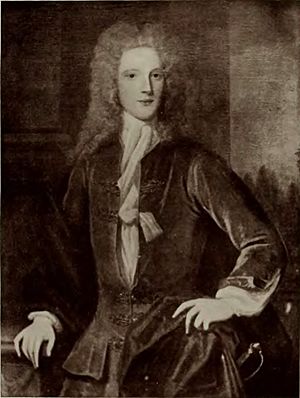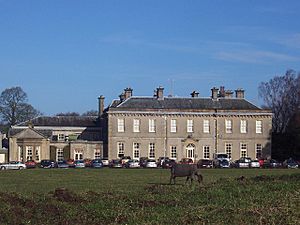Thomas Lister (British politician, born 1688) facts for kids
Quick facts for kids
Thomas Lister
|
|
|---|---|

portrait by Michael Dahl
|
|
| Member of Parliament for Clitheroe | |
| In office 1713–1745 |
|
| Personal details | |
| Born | 1688 |
| Died | 15 May 1745 (aged 56–57) |
| Political party | Tory |
| Spouse | Catherine Assheton (d.1728) |
| Children | 5, including: Thomas Lister (1723–61) Nathaniel Lister |
| Relatives | Thomas Lister, 1st Baron Ribblesdale (grandson) |
| Residence | Gisburne Park |
| Education | Eton College Balliol College, Oxford Middle Temple |
| Occupation | Politician |
Thomas Lister was an important person in British politics who lived from 1688 to 1745. He owned land in Yorkshire, England, and was a politician for the Tory party. He represented the area of Clitheroe in the British Parliament for many years, from 1713 until he died in 1745.
Contents
Early Life and Education
Thomas Lister was born in 1688. He was the oldest son of Thomas Lister and Elizabeth Parker. He went to famous schools like Eton College from 1698 to 1706. After that, he studied at Balliol College, Oxford, starting in 1706 when he was 17. Even though he went to Oxford, he later said he didn't learn much there! In 1706, he took over his father's properties. He also studied law at Middle Temple in 1709.
In 1716, Thomas Lister married Catherine Assheton. Her father was Sir Ralph Assheton. Catherine passed away in 1728.
Political Career
Thomas Lister's family had owned land in Clitheroe since the 1300s. This meant they had a lot of influence in the local elections. In 1713, Thomas Lister became a Member of Parliament (MP) for Clitheroe. An MP is a person elected to represent a group of people in the House of Commons, which is part of the British Parliament.
When he first started, he was described as a "very young gentleman" but also "honest." He was part of the Tory party, which was one of the main political groups at the time. Even though he was a Tory, he sometimes voted against his party's usual stance, like when he voted against a trade bill with France in 1713.
In the 1715 election, Lister was re-elected as MP for Clitheroe. His marriage in 1716 helped him gain even more local support. By the 1722 election, he had enough influence to control one of the seats in Clitheroe. He often voted against the government's plans. For example, in 1728, he spoke out against a "vote of credit," which was a way for the government to get money quickly without much debate.
Gisburne Park Development
Thomas Lister decided to move his family's main home from Arnoldsbigging to Lower Hall in Gisburn. His father had bought Lower Hall in 1697. Between 1726 and 1736, Thomas Lister rebuilt Lower Hall, turning it into the grand Gisburne Park.
The house has two floors and is shaped like an "H." The front of the house has nine sections, with the middle three set back slightly. It is covered in small stones with sandstone decorations and has a sloped slate roof. The park around the house was also improved, with designs created by Robert, 8th Lord Petre.
Because of his strong local influence, Thomas Lister was re-elected as MP for Clitheroe without anyone running against him in the elections of 1727, 1734, and 1741.
Death and Family Legacy
Thomas Lister passed away on May 15, 1745. He was buried in Gisburn a week later. He had two sons and three daughters. Sadly, one of his daughters died before him.
Both of his sons, Thomas and Nathaniel Lister, also became Members of Parliament for Clitheroe, following in their father's footsteps. His grandson, Thomas, also served as MP for Clitheroe and was later given the title of Baron Ribblesdale, which is a noble title. This shows how important the Lister family was in the politics of Clitheroe for many years.


